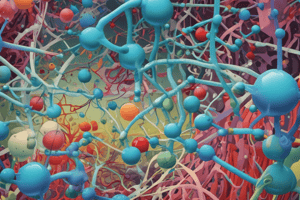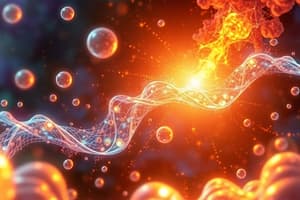Podcast
Questions and Answers
What occurs to the Vmax when an uncompetitive inhibitor is present?
What occurs to the Vmax when an uncompetitive inhibitor is present?
- Vmax increases significantly
- Vmax becomes lower than in the absence of the inhibitor (correct)
- Vmax is eliminated completely
- Vmax remains unchanged
What effect does an uncompetitive inhibitor have on the apparent KM value?
What effect does an uncompetitive inhibitor have on the apparent KM value?
- It decreases the apparent KM value (correct)
- It increases the apparent KM value
- It alters the KM value in an unpredictable manner
- It does not affect the KM value at all
Which statement is true regarding the effect of a non-competitive inhibitor on the enzyme-substrate interaction?
Which statement is true regarding the effect of a non-competitive inhibitor on the enzyme-substrate interaction?
- The non-competitive inhibitor increases the KM value
- The non-competitive inhibitor does not affect the substrate binding to the enzyme (correct)
- The non-competitive inhibitor completely prevents substrate binding
- The non-competitive inhibitor enhances the substrate binding affinity
How does the presence of a non-competitive inhibitor affect Vmax and KM?
How does the presence of a non-competitive inhibitor affect Vmax and KM?
What happens to the concentration of functional enzymes when a non-competitive inhibitor is introduced?
What happens to the concentration of functional enzymes when a non-competitive inhibitor is introduced?
Which statement accurately describes the role of allosteric inhibitors in enzyme function?
Which statement accurately describes the role of allosteric inhibitors in enzyme function?
What is the significance of the regulatory enzyme in a metabolic pathway?
What is the significance of the regulatory enzyme in a metabolic pathway?
Which method of enzyme regulation occurs through the activation of proteolytic enzymes?
Which method of enzyme regulation occurs through the activation of proteolytic enzymes?
Which type of regulation allows an end product to influence its own synthesis?
Which type of regulation allows an end product to influence its own synthesis?
What impact does covalent modification, such as phosphorylation, have on enzyme activity?
What impact does covalent modification, such as phosphorylation, have on enzyme activity?
What is the defining feature of a reversible inhibitor?
What is the defining feature of a reversible inhibitor?
Which type of inhibitor competes with the substrate for binding to the active site?
Which type of inhibitor competes with the substrate for binding to the active site?
How does a competitive inhibitor affect the apparent Km (KM,app) of an enzyme?
How does a competitive inhibitor affect the apparent Km (KM,app) of an enzyme?
What occurs when an uncompetitive inhibitor binds to an enzyme-substrate complex?
What occurs when an uncompetitive inhibitor binds to an enzyme-substrate complex?
Which characteristic is true for a noncompetitive inhibitor?
Which characteristic is true for a noncompetitive inhibitor?
Which of the following best describes the effect of increasing substrate concentration in the presence of a competitive inhibitor?
Which of the following best describes the effect of increasing substrate concentration in the presence of a competitive inhibitor?
What type of binding site do competitive inhibitors typically target?
What type of binding site do competitive inhibitors typically target?
Which statement about irreversible inhibitors is true?
Which statement about irreversible inhibitors is true?
Which of the following inhibitors does not affect Vmax but alters the Km?
Which of the following inhibitors does not affect Vmax but alters the Km?
What effect does Penicillin have on enzymes?
What effect does Penicillin have on enzymes?
How does Aspirin function at the biochemical level?
How does Aspirin function at the biochemical level?
What is a characteristic of allosteric activators?
What is a characteristic of allosteric activators?
What is the effect of irreversible inhibition on Km?
What is the effect of irreversible inhibition on Km?
Which of the following statements best defines non-competitive inhibition?
Which of the following statements best defines non-competitive inhibition?
In terms of enzyme affinity, what happens when an allosteric inhibitor is present?
In terms of enzyme affinity, what happens when an allosteric inhibitor is present?
Flashcards
Allosteric Inhibition
Allosteric Inhibition
A type of enzyme regulation where a molecule binds to an enzyme at a site other than the active site, changing its conformation and decreasing its activity.
Rate-Limiting Enzyme
Rate-Limiting Enzyme
The enzyme in a metabolic pathway with the slowest reaction rate, controlling the overall speed of the pathway.
Feedback Regulation
Feedback Regulation
A mechanism where the end product of a metabolic pathway inhibits an earlier enzyme in the same pathway, controlling its own synthesis.
Zymogen
Zymogen
Signup and view all the flashcards
Covalent Modification
Covalent Modification
Signup and view all the flashcards
Reversible Inhibitor
Reversible Inhibitor
Signup and view all the flashcards
Competitive Inhibitor
Competitive Inhibitor
Signup and view all the flashcards
How does a Competitive Inhibitor affect Km?
How does a Competitive Inhibitor affect Km?
Signup and view all the flashcards
How does a Competitive Inhibitor affect Vmax?
How does a Competitive Inhibitor affect Vmax?
Signup and view all the flashcards
Uncompetitive Inhibitor
Uncompetitive Inhibitor
Signup and view all the flashcards
How does an Uncompetitive Inhibitor affect Km?
How does an Uncompetitive Inhibitor affect Km?
Signup and view all the flashcards
How does an Uncompetitive Inhibitor affect Vmax?
How does an Uncompetitive Inhibitor affect Vmax?
Signup and view all the flashcards
Key Features of Competitive Inhibitor
Key Features of Competitive Inhibitor
Signup and view all the flashcards
How Irreversible Inhibitors Affect Enzyme Kinetics
How Irreversible Inhibitors Affect Enzyme Kinetics
Signup and view all the flashcards
Penicillin: Example of Irreversible Inhibitor
Penicillin: Example of Irreversible Inhibitor
Signup and view all the flashcards
Aspirin: How it Works as an Inhibitor
Aspirin: How it Works as an Inhibitor
Signup and view all the flashcards
Allosteric Regulation
Allosteric Regulation
Signup and view all the flashcards
Allosteric Activators
Allosteric Activators
Signup and view all the flashcards
How does a non-competitive inhibitor affect Vmax and Km?
How does a non-competitive inhibitor affect Vmax and Km?
Signup and view all the flashcards
Study Notes
Enzyme Regulation
- Reversible Inhibitors: A compound that reduces the reaction velocity by binding to the enzyme. It's reversible if it's not covalently bound and can dissociate readily.
- Classified by their relationship to the substrate:
- Competitive: Competes with the substrate for binding at the enzyme's substrate-recognition site. Usually a close structural analog of the substrate. Increasing substrate concentration overcomes the inhibitor.
- Noncompetitive: Binds to the enzyme at a site other than the active site. Decreases Vmax, but Km remains unchanged.
- Uncompetitive: Binds only to the enzyme-substrate complex (ESI). Decreases both Vmax and Km.
- Classified by their relationship to the substrate:
Competitive Inhibitor (CI)
- Both inhibitor and substrate bind to the same site on the enzyme.
- This binding for both is reversible.
- To overcome the inhibitor, increase the substrate concentration.
- Increasing substrate concentration raises the apparent KM of the enzyme (KM,app).
- Increasing substrate concentration is necessary to saturate the enzyme.
- Competitive inhibitors have no effect on Vmax.
Uncompetitive Inhibitor
- Binds only to the ES complex (enzyme-substrate complex).
- This enzyme-substrate-inhibitor complex (ESI) does not form any product.
- Decreases both Vmax and KM.
Non-competitive Inhibitor
- Inhibitor binds to the enzyme on a different binding site.
- Decreases Vmax, but KM remains unchanged.
- The concentration of functional enzymes is lower.
Irreversible Inhibitor
- Binds to the enzyme's active site irreversibly via a covalent bond.
- Decreases Vmax, but Km remains unchanged.
- Concentration of functional enzymes is lower.
Examples of Irreversible Inhibitors
- Penicillin: A covalent bond with the OH group of Serine residue at the active site of Glycopeptide transpeptidase; inhibits cell wall synthesis in bacteria.
- Aspirin: Non-competitive and irreversible acetylation of COX enzyme; blocks the biotransformation of arachidonic acid into prostaglandins.
Allosteric Activators and Inhibitors
- These are compounds that bind to sites other than the active catalytic site on an enzyme.
- Allosteric Activators: Increase enzyme affinity for the substrate by changing the conformation of the catalytic site. Increased enzyme in the active state facilitates substrate binding.
- Allosteric Inhibitors: Bind more tightly to the T state (inactive form), so either the substrate concentration or activator concentration must increase to overcome the inhibitor's effects.
Other Ways for Enzyme Regulation
- Regulation of Gene Expression: Controls the quantity and rate of enzyme synthesis (induction or repression).
- Zymogen Cleavage: Some enzymes are synthesized as inactive precursors (zymogens), which are activated by proteolysis.
- Covalent Modification: Chemical modification (e.g., phosphorylation) of serine, threonine, or tyrosine residues on the enzyme.
Feedback Inhibition
- The end product of a metabolic pathway controls its own synthesis rate.
- The end product might allosterically inhibit an earlier enzyme or inhibit the transcription of the gene for an earlier enzyme in the pathway and thus control the rate.
Studying That Suits You
Use AI to generate personalized quizzes and flashcards to suit your learning preferences.




